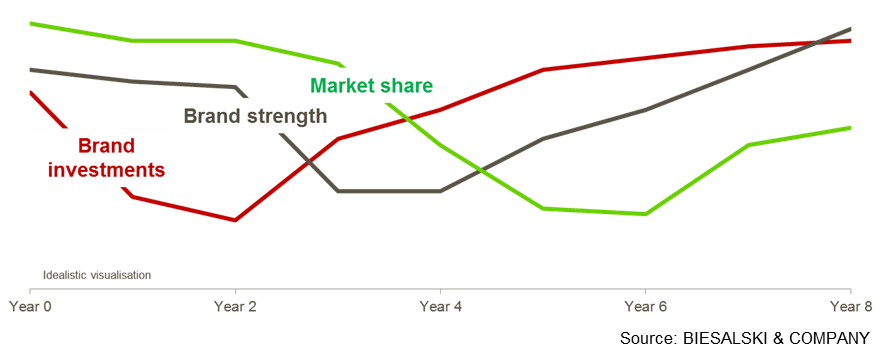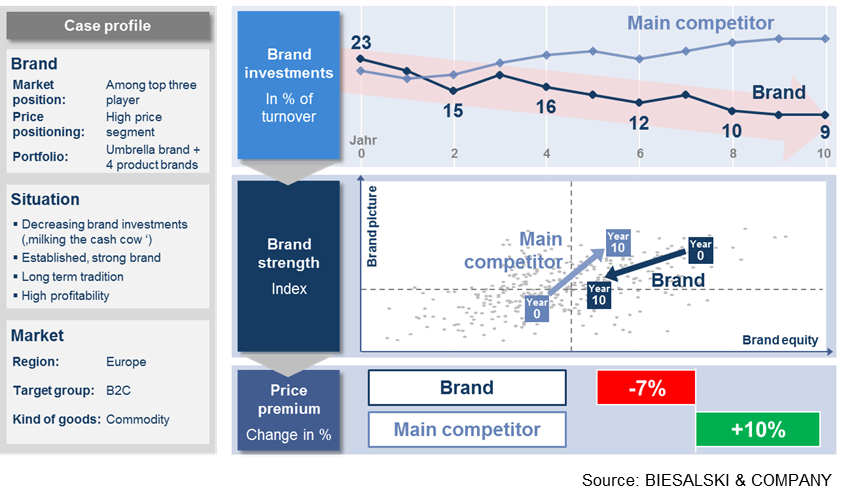Author: Jan Kubik
Imagine you want your plants to thrive and prosper. What would you do? Even with the smallest green thumb, regular and continuous watering seems to be obvious. Otherwise, you would risk that the plant dries out. In this case, the plant is damaged it or at least its rescue takes much more effort while using more water and fertilizer.
Probably you are now wondering why I am talking about plants. It is because growing a prosper plant is similar to developing a strong brand. A strong brand is a value-adding factor. On an average, the brand value accounts for almost 50 percent of the company value (BIESALSKI & COMPANY, benchmark database, 2016). However, to get there the brand needs continuous and regular investments at an appropriate level. Pretty much as the plant, that needs water to grow.
To be aware of the relevance of brand investments is so important because they are directly manageable and assignable to efficient measures in the marketing mix. Having said that, it is the only way to influence the buying decision of the customer by increasing his perception, attitude and preference towards the brand. In turn, this can raise the market share and economic success of the company (see illustration below).

How to become a strong brand?
Creating a strong brand takes time and needs continuity of brand investments. This is not only a matter of fact in B2C but also in B2B. When you think about brand investments, you probably first come up with strong consumer brands like Apple, Google and Co. However, also more unknown brands in the B2B sector like Herrenknecht or Otto Bock are equally strong in their specific target group. Why? Because they have invested in the brand over decades in a focused and efficient manner. Less in advertisement but rather in innovations, product and service quality and customer orientation (BIESALSKI & COMPANY, „Die Marken der deutschen Hidden Champions 2015“). As investments have a delayed impact on the value added of the brand (e.g. in terms of higher market shares) it is important to spend the money sustainably in the long-term, as the graphic below illustrates.

Missing brand spending will result in brand erosion
So far, it is all best practice. Think about a company that exploits its brand while investing in it only on a low level. That is unfortunately also common practice. It is the same as for the plant without water – the brand will erode. How this looks like in a specific example can be seen in the case below. Based on a real example of a once leading German commodity producer we can see that first the brand picture gets less clear, attractive and differentiating to the customers. Consequently trust and loyalty decreases leading to a lower brand equity. Based on this, customers penalise the brand with a lower willingness to pay leading to a decrease in price premium. Concisely, the brand got in serious problems only within 10 years whereas the main competitor did well and out-competed the brand.

To sum up: Care about your brand, put enough money in it and increase business success
Keep in mind that the brand is a crucial value-adding factor. If you want to profit from the brand, put sufficient money in it in the long-term. The brand will reward you with higher sales and prices. The best thing about that: The output should be much higher than the amount of spending you put into the brand – provided you did the most things right. You want to learn how Hidden Champions do things right? Read the study ‘Die Marken der Hidden Champions 2015’.




